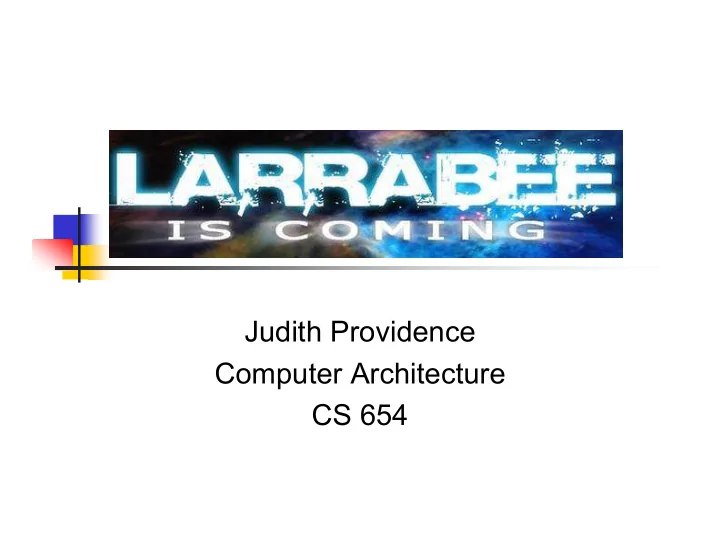

Judith Providence Computer Architecture CS 654
Outline Background/Motivation Multi-processors Larrabee Architecture Performance studies Evaluation Conclusion 4/30/09 W&M CS 654 2
Motivation:Trends Towards Many-core Processors Power Growth in HPC Decrease performance in uniprocessors Limits on Instruction-Level Parallelism Register renaming Branch prediction Jump prediction Memory address Alias Analysis Perfect caches 4/30/09 W&M CS 654 3
Larrabee:GPU or CPU? Larrabee CPU GPU It supports 4 threads PCI bus Efficient inter-block Only a minimum communication amount of memory Ring network for full inter-processor available communication Only single- Each Larrabee core is a complete x86 core that precision floating supports point performance Virtual memory and page swapping Fully coherent caches at all levels 4/30/09 W&M CS 654 4
Larrabee:CPU Larrabee a in-order many-core x86 CPU Intel president in 2005 stated: We are dedicating all of our future product development to multi-core designs. Multi-core processors vs. many-core processors GPU-like capabilities 4/30/09 W&M CS 654 5
Motivation for an in-order CPU Comparison between a modern out-of- order CPU, the Intel Core2Duo processor, and a in-order test CPU design based on the Pentium processor with a 16-wide VPUs 4/30/09 W&M CS 654 6
Multi-processors Inter-processor Communication Inter-processor Ring Network Computation SIMD vector processing unit, mask register Shared Memory Coherent cached memory hierarchy, MIMD Model Synchronization Mechanisms Semaphores, Software locks 4/30/09 W&M CS 654 7
Larrabee Architecture 4/30/09 W&M CS 654 8
Core Design of Larrabee Larrabee CPU core and associated system blocks: the CPU is derived from the Pentium processor in-order design, plus 64-bit instructions, multi-threading and a wide VPU. Each core has fast access to its 256KB local subset of a coherent 2nd level cache. L1 cache sizes are 32KB for Icache and 32KB for Dcache. Ring network accesses pass through the L2 cache for coherency. 4/30/09 W&M CS 654 9
Inter-processor Ring Network Bi-directional Routing decisions made before messages are placed into the network Checks for data sharing Provides a path for the L2 cache to access memory Allows Fixed Function Logic agents to be accessed by the CPU cores Scaling to more than 16 cores 4/30/09 W&M CS 654 10
Wide Vector Processing Unit SIMD 16 lanes Executes integer and Floating point instructions Scatter gather supports a Maximum of 16 elements 4/30/09 W&M CS 654 11
Fixed Function Logic Unit Used for Graphical tasks Larrabee uses software in place of a fixed functional unit for some graphical tasks Cores pass commands to the texture unit through the L2 cache Texture filter logic would be 12x to 40x longer in software 4/30/09 W&M CS 654 12
Advanced Applications Larrabee supports irregular data structures An efficient scatter-gather support for irregular data structures The SIMD vector processing unit can be programmed Intel’s auto-vectorization computer technology 4/30/09 W&M CS 654 13
Performance Study Spectral methods/Dense Linear algebra Data is in the frequency domain High Performance Kernel-3D-FFT Data that are dense matrices or vectors -BLAS-3 4/30/09 W&M CS 654 14
High Performance Computing Kernels Simulation results are based on Stanford’s PhysBam http://physbam.standford.edu/~fedkiw Amdahl’s Law:Speedup maximum =1/(1-fraction enhanced) 4/30/09 W&M CS 654 15
Evaluation of Larrabee for parallel applications con Memory contention - Lack of error correcting - code(ECC) memory, Graphic double data rate Shortage of double - precision floating point capability pro - Load balancing is accomplished by moving processes - Supports irregular data structures 4/30/09 W&M CS 654 16
Conclusion-Relevance of Larrabee for the Future Amdahl’s Law - Limitations in parallelism make it difficult to achieve good speedup 1965 - Moore’s Law states that the number of transistors on a chip will double about every two years Need a Moore’s Law to handle software Solution: the establishment of academic communities 4/30/09 W&M CS 654 17
Recommend
More recommend